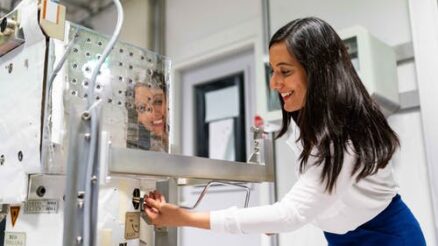As veterinary medicine continues to evolve, it becomes increasingly crucial for pet owners and veterinarians alike to stay informed about the latest advancements. Staying up-to-date on cutting-edge technologies and treatment options ensures the best possible care for our beloved pets. This article delves into the top 5 breakthroughs in veterinary internal medicine, shedding light on the benefits and practical implications of these innovations.
1. Minimally Invasive Diagnostic and Surgical Techniques
Gone are the days of relying solely on traditional surgical methods for both diagnosis and treatment. Veterinary medicine has embraced minimally invasive techniques, which have proven to be more comfortable, safer, and more effective for our pets. But what exactly are minimally invasive diagnostic and surgical techniques? In essence, these methods involve using tiny instruments and cameras to access the body without the need for large incisions.
For instance, endoscopy and laparoscopy are two common minimally invasive procedures that allow veterinarians to examine an animal’s internal organs and tissue structures in real-time. These techniques provide clinicians with a wealth of information that would be otherwise unattainable through conventional means. Moreover, minimally invasive procedures generally entail shorter recovery times, reduced pain, and fewer post-operative complications. It’s a win-win situation for pets and their owners.
Internal Medicine Vet
An internal medicine veterinarian in Placentia, CA, like those at many other well-regarded veterinary practices, is highly trained in diagnosing and treating complex conditions in animals through minimally invasive techniques. By adopting these cutting-edge approaches, veterinary professionals can give pet owners peace of mind and improve their pets’ overall health and well-being.
2. Advanced Imaging Technology
Another major breakthrough in veterinary internal medicine is the use of advanced imaging technologies, such as CT scans, MRI scans, and ultrasound, to provide accurate diagnoses and treatment options. These imaging tools allow veterinarians to obtain high-resolution, detailed images of an animal’s internal structures without causing discomfort or harm.
Early detection and accurate diagnoses are paramount to successful disease treatment, and advanced imaging techniques have made it possible to identify health issues with increased precision. Veterinarians can now catch and address medical concerns at their earliest stages, ultimately improving the prognosis and quality of life for our furry companions.
Veterinary Clinic
At a reputable veterinary clinic like Yolinda Animal Hospital, state-of-the-art imaging technology plays a crucial role in providing the best possible care for our pets. By taking advantage of these advanced diagnostic tools, veterinary professionals can devise personalized treatment plans that cater to an animal’s unique health needs and alleviate any discomfort they may be experiencing.
3. Stem Cell Therapy and Regenerative Medicine
Regenerative medicine, particularly stem cell therapy, represents a highly promising and innovative aspect of veterinary internal medicine. In recent years, veterinary professionals and researchers have shown keen interest in exploring the potential applications of stem cell therapy in animals. This groundbreaking treatment involves using an animal’s own stem cells, which are naturally occurring cells that have the ability to develop into different types of tissue, to help repair damaged or aging tissue. Essentially, this allows for faster healing and potential regeneration of damaged body parts.
Current applications of stem cell therapy include treatment for arthritis, hip dysplasia, and tendon/ligament injuries in animals. Many pet owners have observed remarkable improvements in their pets’ mobility and overall quality of life following treatment. The research in this field is ongoing, and the full scope of stem cell therapy’s potential remains to be discovered.
4. Personalized Medicine and Genetic Testing
Genetics play a significant role in veterinary internal medicine, particularly in the development of personalized treatment plans. With advances in genetic testing, veterinarians can now identify specific genetic mutations that predispose animals to certain diseases or conditions. This information is invaluable when it comes to creating customized treatment protocols to best meet an animal’s health requirements.
For example, genetic testing can determine if a dog is predisposed to a condition like hip dysplasia. In cases like these, preventative measures and early interventions can be put in place to help minimize the potential for disease progression or complications. Timely genetic testing ultimately leads to better disease management and improved quality of life for our pets.
Pet Vaccinations
One vital aspect of preventative medicine is ensuring that our pets receive the appropriate vaccinations. Genetic testing can play a role in determining which specific dog vaccinations are most beneficial based on breed, age, and other factors. Ensuring our pets are vaccinated not only keeps them healthy but also helps prevent the spread of diseases to other animals and, in some cases, humans.
5. Telemedicine and Remote Monitoring
As telemedicine gains traction in human healthcare, veterinary practices have also begun to adopt this innovative approach. Telemedicine encompasses the use of virtual consultations, remote monitoring technologies, and electronic communication via various devices to facilitate healthcare delivery. This new frontier in veterinary internal medicine enables pet owners and veterinarians to collaborate effectively from a distance.
Some of the advantages of telemedicine in veterinary medicine include round-the-clock care, increased convenience for pet owners, and the ability to provide medical support for pets located in remote or underserved areas. While telemedicine will never replace the importance of in-person veterinary visits, it is a valuable complement to traditional veterinary care.
Conclusion
In summary, the world of veterinary internal medicine is constantly evolving, with breakthroughs emerging each year that improve the quality of care and the lives of our pets. It’s crucial for veterinarians and pet owners alike to stay informed of these innovations, as they continue to shape the future of animal healthcare. With the ever-growing advancements in technology and veterinary medicine, we can look forward to a brighter future for our beloved pets.


